

 |
 |
 |
Guest - Not logged in | |||||||||||||||||||||||||||||||||||||||||||||||||||||||
Reviews > Packs > Internal and External Framed Backpacks > Lowe Alpine Nanon 50 60 Pack > Test Report by Hollis EasterLowe Alpine Nanon 50:60 Pack
| ||||||||||||||||||||||||||||||||||||||||||||||||||||||||
| Temperature: | Wind: | Elevation: |
|---|---|---|
| 40 F (4 C) to 70 F (21 C) | up to 15 mph (24 kph) | around 1,500 ft (460 m) |
A friend and I hiked along long-disused lumber roads from Coreys Road to Duck Hole, one of the wildest places in the Adirondack park. In many places, the trail sees so little foot traffic as to be almost indistinguishable from the surrounding forest, and it took some skill to remain on the right path. I was surprised to see how quickly the forest has filled in this once-busy corridor.
At Duck Hole, we spent a very enjoyable evening listening to the resident chorus of loons. It began to rain overnight, and we waited out the morning rain inside a lean-to while listening to the loons. We returned by the same route and camped near Mountain Pond before heading to the airport on the morning of the 14th. Total distance hiked was about 23 miles (37 km). The second night was clear and starry, and therefore quite cold.
| Temperature: | Wind: | Elevation: |
|---|---|---|
| 45 F (7 C) | gusts to 54.1 mph (87.1 kph) | 3,694 ft (1,126 m) |
Several friends and I made the 1,600 ft (488 m) climb to Hurricane Mtn in the eastern Adirondack Mountains to celebrate Halloween. We'd planned to wear costumes for the event (and had, actually, intended to climb a different peak) but the weather forecast made us select a less-exposed route. On the summit, I measured sustained winds that approached 50 mph (80 kph), which was neat: when I jumped into the air, I would land a couple of feet away from where I began. Total distance was about 6 miles (10 km).
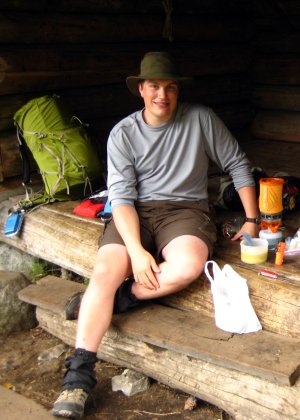
I've used Lowe Alpine packs for years because they fit me well, and the Nanon is no exception. If I had to write a review consisting of a single word, I would choose "comfort". I just love the way the Nanon carries, and it's been a joy to use it.
I thought I'd start by giving a run-down on my current packing methods, since they form the basis of my comments.
I open the main pocket of the Nanon and slip my Platypus 3 liter hydration bladder into the hydration sleeve, and I run the drinking tube out through the slot. I roll up my closed-cell foam sleeping pad (torso-length, since I use it under my legs and feet), place it into the pack, and then allow it to unroll. This lines the pack, keeping the contents protected from the weather, and it also gives the pack some structure.
Into the space thus created, I place my rolled-up Warbonnet Blackbird hammock, then some clothes, then my Jetboil Flash stove, fuel, sleeping quilt, hammock underquilt, and food. If I think I'm going to need to refill my bladder during the day, I just lay it on top of the items in the main pack, rather than using the dedicated sleeve.
Once filled and cinched down, that makes a pretty solid, comfortable mass in the pack. I put my tarp and raincoat into the shove-it pocket on the front, which makes them easy to access in wet weather. I also stashed my gaiters in there when I wasn't wearing them. The shove-it pocket seals down pretty well as long as the main pack is full.
Into the front pocket, just outside the shove-it pocket, I put a bit of food. I don't want anything heavy in there since there's quite a bit of leverage (it's a long way from my back), so I use it to hold my emergency snacks. Since I'm hypoglycemic, I try to make sure that my hiking partners always know where I have a stash of energy foods.
I use the lid pockets for small items that need to be kept in a corral: toiletries, sunglasses, snacks, and maps. Things like my firesteel, mUV ultraviolet water purifier, and MP3 player go into the zippered pocket inside the top pocket. I fill the bigger zippered pocket (the one that's on the "bottom" of the lid) with my first aid kit, headlamp, bag of emergency tinder, spare parachute cord, and the like.
I've been getting used to the hipbelt pockets, and I think I like them. They're pretty small, and the zippers tend to stick when I open and close them (which means I need two hands; difficult while using trekking poles), but they're handy for small items. I can fit a single granola bar into the right-hand one, and that's what I do. I tied my compass's lanyard to the left pocket's zipper pull, and I store the compass in that pocket. This makes it really simple to pull out the compass, shoot a bearing, and stow it again. I like it! I do wish the pockets were larger, though.
The hipbelt is genius. It is completely comfortable, and I am thrilled by it. The little wedge of foam keeps the belt locked into my hips, and I've experienced no chafing or pain so far.
A few small things: the fabric of the pack is water-resistant, not waterproof. This hasn't been a big problem, but it's something I noticed. I'll probably invest in an aftermarket pack cover. I will say that the fabric seems very durable so far—I can't see any visible wear despite the bushwhacking on the way to Duck Hole.
I'm a bit perplexed by the strap lengths Lowe Alpine has chosen. The main straps that hold the lid on are stretched pretty tight when the pack is fully loaded; an extra bit of length would be welcome here. However, the load lifter straps are long enough that they could be quite a bit shorter without any loss of function.
The trekking pole attachments held my poles very securely, and I didn't notice them bouncing around. Although the poles extend well below the bottom of the pack when stowed, they don't seem to catch on brush as I pass by. I'm somewhat surprised by this, but it seems to be true.
I wish there were some hard (non-elastic) attachment points on the shoulder straps. I like to hang my altimeter from the left shoulder strap, and I worry about it getting lost if I hang it on the elastic loop there. I realize that this is probably just a psychological thing, but it's a powerful one.
One final fly in the ointment: the Nanon doesn't work very well for lightly-equipped day trips. I found, on Hurricane, that the contents of my pack tended to shift around even though the pack was fully cinched down. On flat ground, that might be a mere annoyance, but it made the wet and rocky descent of Hurricane's trail a bit more exciting than I might have wished. So, in future, I'll either pack more or use a different backpack on light trips.
I'm in love with the Nanon. It's been extremely comfortable with total weights up to 35 pounds (16 kg), and it's simple to adjust while I'm walking. The shoulder harness is very nice, and the hipbelt is outstanding. Durability has been good so far, and the pack feels pretty stable while I'm hiking. I would buy a new one if mine got lost, and I've suggested the model to my local outdoors store.
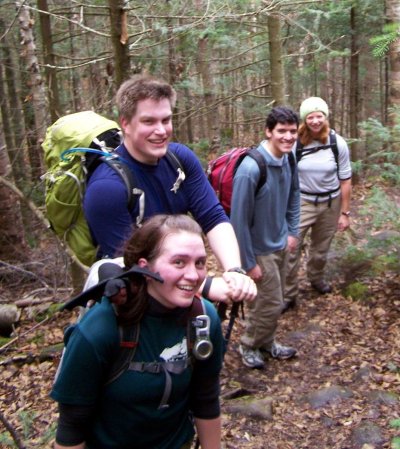
With friends on Hurricane
During this period, I wore the Nanon on six hiking days, all of which took place within the Adirondack Mountains of New York. With a few small caveats, I am still in love with the pack. It fits well, carries comfortably, holds a lot of gear, and feels nearly weightless. It is highly durable, and I plan to continue using it well beyond the end of the test.
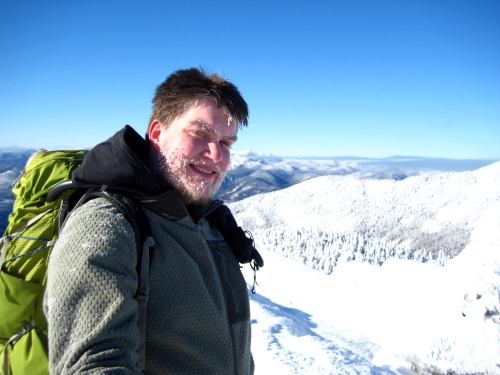
| Temperature: | Wind: | Elevation: |
|---|---|---|
| 35 F (2 C) | up to 15 mph (24 kph) | 3,820 ft (1,164 m) and 3,168 ft (966 m) |
Two friends and I set out for an early-winter warmup on two northern peaks in the Adirondacks. We did a loop climb of the new and old trails on Lyon Mountain, for a total distance of approximately 9 miles (15 km). We then proceeded to Catamount, a smaller peak that blends hiking and scrambling. We made it through the rock chimney and over some exposed rock, but we were stymied by verglas on the upper summit. We decided that discretion was the better part of valor and, tails between our legs, retreated. We'll be back. Total distance on Catamount was approximately 4 miles (6 km).
| Temperature: | Wind: | Elevation: |
|---|---|---|
| 10 F (-12 C) | up to 21 mph (34 kph) | 2,545 ft (776 m) and ~3,200 ft (~975 m) |
We ran up Mount Arab to warm up for the day's exploration of the disused ski slopes on the flanks of Mount Morris, one of the higher peaks in the northwestern Adirondacks. Standing on the summit, I looked out at Santanoni Peak and remembered the life of my friend, Dan Wills, who had died in a plane crash on Santanoni a few weeks before. It felt right to honor his memory from a mountaintop. Total distance was about 8 miles (13 km).
| Temperature: | Wind: | Elevation: |
|---|---|---|
| 5 F (-15 C) to -19 F (-29 C) | up to 22 mph (35 kph) | 4,098 ft (1,249 m) and 4,059 ft (1,237 m) |
We celebrated the last weekend before official winter climbing season with a trip up some of the easier High Peaks. The temperature on the summit was amply cold to furnish icicles in my new beard. We saw lots of people and had some gorgeous views! Total distance was around 7 miles (11 km).
| Temperature: | Wind: | Elevation: |
|---|---|---|
| 0 F (-18 C) | up to 15 mph (24 kph) | not relevant |
A friend and I went to scope out the early-season ice on the south flanks of Azure Mountain, our favorite local ice-climbing venue. Conditions were thin but climbable; we had a great time. Total distance was about 2 miles (3 km).
| Temperature: | Wind: | Elevation: |
|---|---|---|
| 32 F (0 C) | none | not relevant |
My first day of cross-country skiing in 15 years was a blast, if a trifle awkward. We did some moonlit skiing, for a total distance of about 2 miles (3 km).
| Temperature: | Wind: | Elevation: |
|---|---|---|
| 5 F (-15 C) | up to 20 mph (32 kph) | 4,420 ft (1,347 m) and 4,627 ft (1,411 m) |
We ascended two gorgeous High Peaks on one of the first clear days this winter. Both peaks are steep, and we ascended them via the steep Zander Scott trail. Ice bulges in the deep col between the peaks made us glad for the ice axes we brought. On the summits, we had clear views of hundreds of peaks in New York, Vermont, Ontario, and Quebec. What a stunning day!
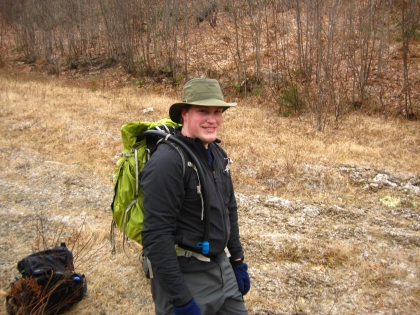
During the Field Report phase, I was concerned about the way that small loads sometimes sloshed around inside the pack. I reasoned that it might help to remove the top lid, so I took it off. I climbed Arab, Morris, Porter, and Cascade Mountains with the pack in lidless mode in order to have some meaningful field experience to share.
With the pack in lidless mode, I use the spindrift collar like the collar of a dry bag: cinch it tight, roll it up tightly, then strap it down to the body of the pack. I found that this was a relatively effective way of closing the pack, and it certainly kept snow out.
Without the lid, the pack suffers from organization issues: fewer pockets means diminished organization. That's to be expected, and it's easy to fix, but it's worth pointing out.
Those caveats aside, the pack works beautifully without its top lid. It also takes on a slightly more squat profile, which is somewhat less likely to catch on overhanging branches while bushwhacking. I enjoyed using the pack in lidless mode, but I eventually switched back to using the lid both because I value the organizational convenience and because winter arrived, giving me reason to carry more gear in the pack's body.
I love the key clip in the lid pocket! The rotating ball-and-socket joint charms me every time I use it. I wish the clip were easier to open with gloves on, but I can't have everything. The clip is also conveniently placed near the lid zipper, which means I can lock my car while the key is already clipped in. This helps prevent brain-dead car problems during those 5 a.m. starts.
It can be hard to load the front pocket when the pack is full, and that still irritates me. I would recommend that Lowe Alpine consider making the front pocket with bellows construction so it could expand. This is a small point, though.
I still haven't fully figured out the reason for the different extensions on the ice axe loops. The ladderlock buckles allow me to change the length of the trekking pole loops, but I can't see any other purpose for them. I am still waiting for enlightenment here. I don't generally use the side elastic pockets--even though they hold items very securely, I get nervous and worry that my gear will fall out. For me, it isn't worth the psychological hassle. Let me point out that this is entirely a mental problem for me: the pockets work just fine, and I don't blame Lowe Alpine for my psychological problems. (I'm sure they're glad to hear that!)
I wanted more secure storage possibilities on the shoulder harness, so I got a Simblissity Unslack Pack to hang from the shoulder strap. This is an aftermarket pocket (previously tested by BackpackGearTest.org) that attaches to the shoulder strap. It holds my altimeter, weather monitor, GPS if carried, and an energy bar. I was unhappy with the elastic gear loops on the front of the shoulder straps, which prompted my purchase of the add-on pocket. I would recommend that Lowe Alpine consider adding a hard mount point or two onto the shoulder straps. A plastic D-ring would be fine.
I wish it were easier to attach snowshoes to the pack, but I have jerry-rigged a solution with cordage. Still, it would be nice if Lowe Alpine would make the side compression straps long enough to hold snowshoes and then put side-release buckles on them.
I finally found something I really dislike about the Nanon when used as a hiking pack: the ice axe attachments. The pack uses the standard bottom loop/top elastic combination, but the two attachment points aren't aligned vertically. This is fine—beneficial, even—when I'm carrying my Petzl Quark ice tools, since their curved shafts fit perfectly. However, when I'm carrying a standard mountaineering axe, the shaft and point of the axe extend horizontally well beyond my shoulders. In practical terms, that means that the axe snags every time I need to duck beneath a fallen tree or low branch. In Adirondack hiking, I do that often—at least twice a minute during much of the Giant and Rocky Peak Ridge trip. I had to pause to free the axe each time, which became very frustrating.
I recommend that Lowe Alpine re-align the upper axe attachments to be closer to the pack's center line. That would bring the axe shaft into line behind my head, which would keep it from getting snagged as often.
Otherwise, I still adore the pack. It is light, capacious, and fairly durable, although I note some peeling of the rubberized coating on part of the hipbelt. I am not concerned since the underlying webbing is sound. Otherwise, the pack looks brand new. The fabric seems to be self-cleaning: I know I've gotten mud on the pack repeatedly, and I have never washed it, but I can't find any traces of the mud anywhere.
Minor carping aside, I love the pack. The Nanon 50:60 is one of the best, most comfortable packs I have ever worn. I find it very suitable for lightweight backpacking, ice climbing, and winter day hiking; it is also adequate for light summer day hiking. Although the pack is very lightweight, it is beefy and strong, and seems very durable. I have packs half its size that weigh just as much.
The harness fits me so well that loads seem to disappear—there are times when I'd swear the designers at Lowe Alpine stuck antigravity pods into this thing. Any lightweight pack will have design compromises, as I've detailed above, but it seems like Lowe Alpine has found the sweet spot here. The Nanon is tough, versatile, and delightful to carry. Although the test period has now ended, my pack stands ready: already loaded for the next adventure.
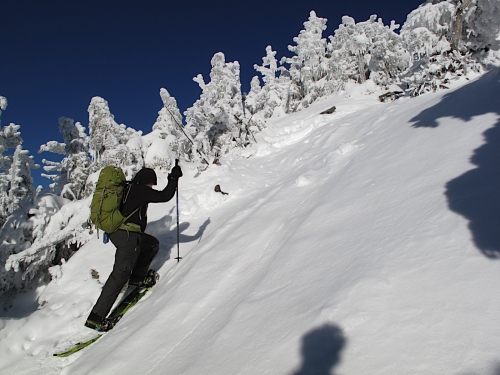
| Likes: | Dislikes: |
|---|---|
|
|
I thank BackpackGearTest.org and Lowe Alpine for allowing me to test the Nanon 50:60 pack. It's fantastic!